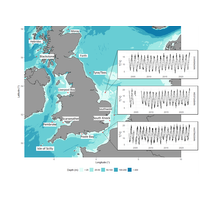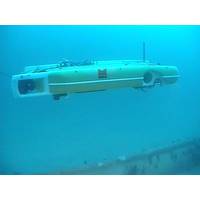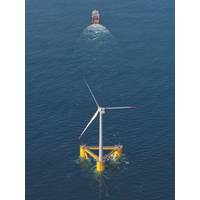
New WaveNet Data Shows Record UK Sea Temperatures
at South Knock beating the last 20 years of data previously collected.While these waters are typically the warmest in the UK, the rise is likely to be the result of an extremely warm summer, particularly in the south and east of England. Across the rest of the UK, temperatures at sites such as Liverpool Bay, Morray Firth, Hebrides, and The Forth, have all reached above average levels.Established in 2002, WaveNet, hosted by Cefas, provides real time wave heights and temperatures from a network of wave buoys located around the UK coastline. The data, collected from a variety of third party platforms

Hybrid AUV Completes Depth of Burial Survey for Offshore Wind Farm
survey of the inter array cable routes on the innogy operated Gwynt-y-Môr offshore wind farm, using the Modus HAUV-2 (Hybrid Autonomous Underwater Vehicle) .The Gwynt-y-Môr Offshore Wind Farm comprises 160 Siemens 3.6MW WTGs located approximately 8 miles from the North Wales coast in Liverpool Bay in water depths ranging between 12m and 28m. The WTG’s are connected by 161 inter array cables which total circa 147km in length. The worksite is known for high subsea currents, so any solution had to cope with current up to 2kts.Modus mobilized its HAUV-2 system, equipped with Optimal

Subsea’s Future is Blowin’ in the Wind
15 minutes, a fully automated aerial drone was able to conduct a top to bottom blade inspection of the world’s largest offshore wind turbine.The innovative inspection was recently performed on the 80m turbine blades of an 8MW MHI Vestas V164 turbine at Burbo Bank Extension, 7km off the coast of Liverpool Bay in the Irish Sea, through a partnership between U.S. based SkySpecs and offshore wind farm developer and operator Ørsted.Denmark based Ørsted (formerly DONG Energy) has roots in the oil and gas industry that go back to the early 1970s. Today, the company is completely focused on

Rovco Wins Gwynt y Môr Windfarm Contract
of its ongoing maintenance plan. Rovco will deploy its Sub-Atlantic Mojave ROV from its fleet, kitted out with 3D inspection equipment as part of the bespoke inspection program. These observation class ROVs are best suited to the issues associated with the strong currents found in the Liverpool Bay area.

PiE 2014 Keynote Speakers Revealed
Colin Jago of Bangor University (U.K.) as keynote speakers at the conference. While Daniel Hanes will elaborate on the confounding effects of particle characteristics on acoustic backscatter measuring techniques, Colin Jago will talk about SPM dynamics in a region of freshwater influence (Liverpool Bay). Together, these talks are guaranteed to resonate with anybody who is curious about the prospects of using acoustics to quantify particle size and/ or concentration as well as studying particle dynamics in physically, biologically and optically complex waters. PiE is a biannual conference

Fugro Win Two Offshore Wind Farm Trenching Contracts
Fugro say they have been awarded two contracts to perform cable burial and survey operations at two wind farm sites in the UK. The first contract is for CT Offshore A/S at RWE Innogy's Gwynt y Môr Offshore Wind Farm located in Liverpool Bay off the North Wales coast. The work involves the burial and post-burial survey of 63 inter-array cables. The second contract is a similar work-scope at a wind-farm located off the UK East coast. The projects will run consecutively with work commencing in January and completing in the 3rd quarter of 2014. Fugro adds that it is mobilising one of its
U.K.'s Liverpool Bay Dredging Secret Discovered
New research tracking the movement of dredged sediment around Liverpool Bay could save millions of pounds in dredging costs. Each year, sediment must be dredged from the port and deposited elsewhere to maintain access for commercial vessels. But according to the new study by scientists at the National Oceanography Center in Liverpool, the dredged material appears back in the port again within just a few weeks of its removal, carried by sea currents. The team used computer models to predict the movement of a particle of dredged material once it had been deposited in the bay. “It's just


 February 2024
February 2024





